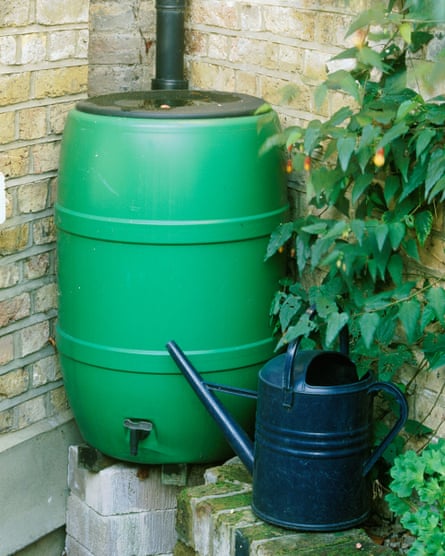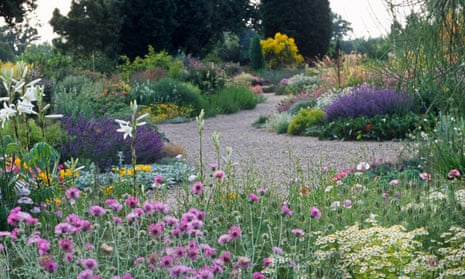All this talk of the likely drought this summer has left me feeling rather smug. I garden in the driest region of Britain: in fact, I garden in the driest part of the driest region in Britain. Beth Chatto’s famous “dry” garden (planted into gravel over a former car park and never, ever, watered) is only 10 miles away. Here in the east we are tooled up and ready to deal with drought - we have to be.
Last week Monty Don tweeted that a drought in Herefordshire was always welcome simply because they never have one there. The division between the prevailing climate in the west, and that in the east, effects our regional culture and traditions. It is not a coincidence that livestock fare the best where the grass grows greenest (it is well watered in the west country) and that the dry east, known in the old days as “corn country”, is favourable for arable or fruit.
Beth Chatto’s garden was a fruit farm before she converted it into a garden. Fruit trees are deep rooted, and unlike cattle have no need of lush, green, fast-growing grass. In fact, fruit trees view grass as a competitor. That is why we clear the area immediately adjacent to the base of their trunks, or let smaller livestock scratch around among them. What fruit trees need is sun. Rearing livestock is converting grass into food; here in the east we tend to farm light and air.

The reason for all this is that the prevailing Atlantic weather systems cross the country from west to east, and spend their moisture as they go. Here in the east we are left with dry air. In the summer high-pressure systems often sit over the North Sea and suck up warm air from Africa only to drop sand across the bonnets of our cars. In the east our winters are typically colder and drier; our summers are hotter and drier. Essex is Britain’s Riviera; the Costa del Colchester.
The unusual position of high-pressure systems this April, together with a feeble jet stream, has left the western seaboard oddly parched from Cumbria to Herefordshire and across the Celtic fringe. Water companies are beginning to talk of shortages. My ten-year-old son has a schoolboy horror of washing (considering almost any other activity a better use of his time), so he is playing his part to conserve water already, and our three girls are too young to do the long lazy bath thing; they share a single tub each evening. Frankly, I have always felt that a childhood spent washing is a wasted one and limiting the trips to the bathroom would be greeted with cheers in this house. But if a hosepipe ban is looming, we must prepare.
I will be planting out over the next few weeks, and as I do, I will attend to the way in which I set plants in the ground. I always create a square or circular plateau around the base of plants with edges of raised soil. This means that what rain there is gets caught and directed towards the roots of the plant rather than simply running off.
Trees and new hedging plants are vulnerable to drought, especially in their first few seasons before their roots have had a chance to work down into the deeper, more moisture-retentive soil below them. As a result I mulch mine with stones; the bigger, the better. I collect the large pieces of flint that come out of the planting holes I dig for them and I save large stones exactly for this purpose. Not only do I find this helps anchor trees to the side of our windy hill, it also locks in water more effectively than soil alone and looks pretty. The new fig trees I have planted in the exotic orchard all have a mulch of attractive multicoloured flint at their toes, which adds to their exotic appeal. But other newbies have anything from horticultural grit through to old bricks. I mulch my pots with stones too, and I use plastic pots as a general rule because they conserve water far more efficiently than terracotta.
The flowerbeds in my garden that are most exposed to the sun also have raised edges, but they are not raised beds in the conventional sense (ie, with soil filled up to the top of the sides) but rather the raised edges sit six or seven inches proud of soil level. For reasons of budget I usually use painted scaffolding boards, but anything will do. Not only does this act as a barrier to encroaching grass, and provide the beds with pleasing structure, it also casts some shading effect around the edges of the flowerbed, easing evaporation from the soil in high summer.
Finally, starting a purposeful weeding regime now will greatly aid your chances of surviving a drought, because none of the precious subterranean moisture that has accumulated over the winter will be lost to extraneous weeds. If we do get a hosepipe ban, and if all else fails, I have a duck pond. But, if you don’t have the time or inclination to dig a pond, putting in water butts is a good idea. They can be extensively plumbed into guttering or, more simply, placed under the overhanging roof of a garden shed. If possible, place them in the shade.
If you can be bothered, grey water (for example from the bath), is fine to use on ornamentals provided it contains no bleach or disinfectant You can always tell where a gardener’s heart truly lies by their response to a hosepipe ban. Faced with an emergency, we’ll make every effort to save our plants; watering cans have been known to emerge from top floor windows here.
